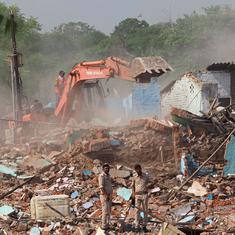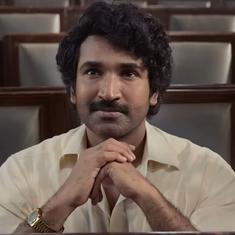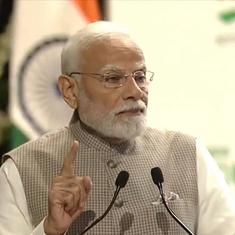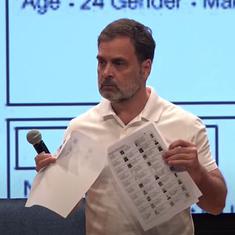The India-Pakistan conflict in May left a deep chasm in the subcontinent. It also revealed a breakdown on both sides of the border on what constitutes fact and the truth.
This reflects an unprecedented polarisation of views, a retreat into echo chambers and a demonisation of the enemy that results in war being projected as the only solution to discord.
Propaganda during war and claiming crushing victories over the opponent are old strategies, of course.
On December 16, 1971, for instance, Pakistani President Yahya Khan, despite the crushing defeat by India in a conflict that resulted in his country being bifurcated, pledged “war till final victory”.
It was not surprising that Pakistan’s current army chief, General Asim Munir, declared victory in the recent conflict and promoted himself to the rank of field marshal despite several international observers and news reports asserting that India had gained an upper hand over Pakistan militarily.
However, strategically or politically neither side seems to have emerged with a conclusive advantage.

It is easy to understand why Pakistan, a smaller power that is effectively under military rule, is inhabiting a post-truth world – but India doing the same is not.
After all, India is a democracy, four times larger than Pakistan in size, seven times in population, 10 times in military spending and 11 times in gross domestic product.
What we witnessed in the Indian media during the conflict was not mere propaganda but a deliberate subversion of what constitutes the truth.
It was not just ordinary citizens on social media who were sharing videos from Gaza claiming that they depicted strikes on Pakistan. Mainstream media outlets did so too.
Headlines such as “India attacks Karachi first time since 1971”, “Pakistan Capital Islamabad Captured,” and “Pak Army Surrenders” featuring on India’s established media networks reflect a shocking disregard for the truth.
The philosopher Jean Baudrillard, writing in the heyday of television, argued that the proliferation of screens and images had altered our sense of reality. “The reality has been driven out of reality,” he observed. When technical simulation overwhelms reality, he said, illusion becomes “the fundamental rule”.
His assertion that “we live in a world where there is more and more information, and less and less meaning” is more pertinent for the social media era where ordinary citizens, and not the media, produce the largest amount of simulated content.
Yet, the misinformation being aired cannot be dismissed as mere social media activity, like memes and clips being shared without meaning. It is the consequence of fundamental changes in India’s cultural and political landscape over the last decade: deepening religious majoritarianism and rising hate speech, the stifling of dissent, increasing hyper-nationalism and the government claiming to its citizens that the country is a vishwaguru – a teacher for the world.
Social media technologies are amplifying these pathologies.
The current milieu is marked by what scholars Jeffrey Berry and Sarah Sobieraj describe as “outrage rhetoric” in which mockery, fear mongering and conspiracy theories predominate. It is a time when a Hindu-owned establishment in India called Karachi Bakery was vandalised. It is a time when some confectioners decided to change the name of Mysore Pak to Mysore Shree – ignorant of the fact that “pak” means “sweet” in Kannada.
Since the Pahalgam terrorist attack on April 22, India’s mainstream media has bristled with belligerence targeting not just Pakistan but also Kashmiris and Indian Muslims. It has spread disinformation but has failed to question the government about security lapses that contributed to the terror attack.

The differences between Pahalgam and Mumbai 26/11 are stark. In Mumbai in 2008, there was jingoism, just as there is now, but the mainstream media was scathing in its criticism of government failures.
Now, vociferous assertions of nationalism have led to fabricated claims to establish superiority. When prominent TV channels flashed headlines claiming that Indian forces had entered Pakistan, it was not accidental misinformation or a psychological operation during war. It represented an entire belief system – a spurious narrative that cannot be corrected by fact checks.
This is a universe that does not tolerate weakness. That is why there was a backlash against India’s foreign secretary when he announced that a ceasefire had been reached. Also under fire was the country’s chief of defence staff, after he seemed to admit that Indian aircraft had been lost in the conflict.
It is a universe of victimhood in which reports by credible foreign media outlets on the same losses were angrily dismissed as an attack against the nation.
In democracies with a hyper-nationalist culture, extreme aversion to dissenting ideas is an essential feature. Ironically, this mimics the state across the border that is not a democracy.
For instance, in 2018, after the terror attack on India’s commercial capital, the Pakistani newspaper Dawn faced censure when it carried an interview with former prime minister Nawaz Sharif in which he asked, “Militant organisations are active. Call them non-state actors, should we allow them to cross the border and kill 150 people in Mumbai?”
In India, a professor was arrested for remarking that the optics of the military briefings about Operation Sindoor, featuring a Hindu and Muslim army officer, seemed incongruous with the injustices routinely faced by ordinary Muslims.
In such a climate, it is not just the perpetrators and their backers who are viewed as monsters, but the entire population of Pakistan. This ignores the fact that the rights of ordinary Pakistanis are shackled by an authoritarian army – an army that is unpopular among many sections of society.
The Indian government’s decision not to pursue the military option after the Mumbai attack was criticised, the strategy of seeking justice through other channels ensured that the focus stayed firmly on the terror attack. Though the Pakistani state tried to absolve itself of culpability, many of Pakistan’s people and civil society were sympathetic to India.
Pakistani media outlets Dawn and Geo News verified information about the family and village of the sole surviving attacker, Ajmal Kasab. Articles in the Pakistani press urged readers “to see the horrors inflicted in the name of Islam… and the need to share the agony of our neighbours” and even apologised to Indians.
A former head of the Federal Investigating Agency asked if Pakistan, as “a nation [is] prepared to muster the courage to face uncomfortable truths and combat the demons of militancy”?
In the post-truth era, such empathy and agreements on facts across national and ideological borders have been rendered evanescent.
Those who advocate war as the only way to avenge the Pahalgam killings ignore the fact that the lowest number of deaths from terrorism in Kashmir since 1989 – 121 – was reached in 2012, four years after 26/11. This number has not reduced further since then.
Terrorism, which has claimed the lives of nearly 22,000 civilian and security personnel in India and 32,000 in Pakistan in the past 25 years, is an ideal plank on which to build solidarity and empathy between people on both sides of the border.
In a climate where citizens are constantly primed by the media and political leadership to seek military solutions, it is not surprising that anti-war positions have become irrelevant in both nations.
The greatest tragedy of the recent conflict is not just the spectre of a full war, and the lives lost but that the post-truth era has ensured that India-Pakistan relations in the foreseeable future will be seen only through the prism of military resolutions, unironically celebrated as the “new normal”.
Nissim Mannathukkaren is a professor at Dalhousie University in Canada. His X handle is @nmannathukkaren.










